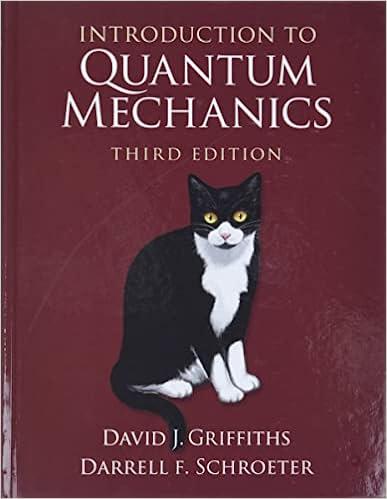Suppose (a) Solve the (time-independent) Schrdinger equation for this potential. by letting z x and y(z)
Question:
Suppose
 (a) Solve the (time-independent) Schrödinger equation for this potential.
(a) Solve the (time-independent) Schrödinger equation for this potential.![]() by letting z Ξ αx and y(z) Ξ (1/√α) Ψ (x) (the √a is just so y (z) is normalized with respect to z when Ψ (x) is normalized with respect to x) . What are the constants a and ε? Actually, we might as well set α → 1 — this amounts to a convenient choice for the unit of length. Find the general solution to this equation (in Mathematica DSolve will do the job). The result is (of course) a linear combination of two (probably unfamiliar) functions. Plot each of them, for (-15 < z < 5). One of them clearly does not go to zero at large z (more precisely, it’s not normalizable), so discard it. The allowed values of ε (and hence of E) are determined by the condition Ψ (0) = 0. Find the ground state є1 numerically (in Mathematica Find Root will do it), and also the 10th, є10. Obtain the corresponding normalization factors. Plot Ψ1 (x) and Ψ10 (x), for 0 ≤ z ≤ 16. Just as a check, confirm that Ψ1 (x) and Ψ10 (x) are orthogonal.
by letting z Ξ αx and y(z) Ξ (1/√α) Ψ (x) (the √a is just so y (z) is normalized with respect to z when Ψ (x) is normalized with respect to x) . What are the constants a and ε? Actually, we might as well set α → 1 — this amounts to a convenient choice for the unit of length. Find the general solution to this equation (in Mathematica DSolve will do the job). The result is (of course) a linear combination of two (probably unfamiliar) functions. Plot each of them, for (-15 < z < 5). One of them clearly does not go to zero at large z (more precisely, it’s not normalizable), so discard it. The allowed values of ε (and hence of E) are determined by the condition Ψ (0) = 0. Find the ground state є1 numerically (in Mathematica Find Root will do it), and also the 10th, є10. Obtain the corresponding normalization factors. Plot Ψ1 (x) and Ψ10 (x), for 0 ≤ z ≤ 16. Just as a check, confirm that Ψ1 (x) and Ψ10 (x) are orthogonal.
(b) Find (numerically) the uncertainties σx and σp for these two states, and check that the uncertainty principle is obeyed.
(c) The probability of finding the ball in the neighborhood dx of height x is (of course) ![]() The nearest classical analog would be the fraction of time an elastically bouncing ball (with the same energy, E) spends in the neighborhood dx of height x (see Problem 1.11). Show that this is
The nearest classical analog would be the fraction of time an elastically bouncing ball (with the same energy, E) spends in the neighborhood dx of height x (see Problem 1.11). Show that this is
 or, in our units (with α = 1),
or, in our units (with α = 1),
 Plot ρQ (x) and ρc (x) for the state Ψ10 (x), on the range 0 ≤ x ≤ 12.5; superimpose the graphs (Show, in Mathematica), and comment on the result.
Plot ρQ (x) and ρc (x) for the state Ψ10 (x), on the range 0 ≤ x ≤ 12.5; superimpose the graphs (Show, in Mathematica), and comment on the result.
Step by Step Answer:

Introduction To Quantum Mechanics
ISBN: 9781107189638
3rd Edition
Authors: David J. Griffiths, Darrell F. Schroeter





